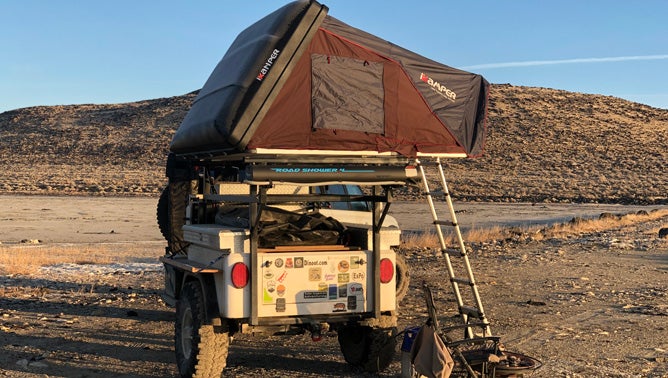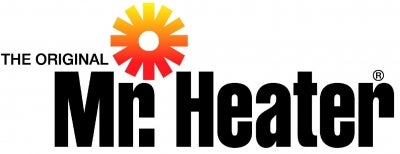We had a chance to test out the iKamper Skycamp for more than a year of four-season use before putting together this final review.
Follow the rooftop tent market and you’ll soon find that replication is the driving philosophy of most brands. This is understandable given the appeal of existing designs, coupled with the ability to have an overseas factory produce variations on existing popular models. Conceived and patented in Italy at the end of the 1950s, the rooftop tent (RTT) emerged in both a flip open form – by Air-Camping – and a vertical lift form – later to become Autohome. Their benefits drew rapid interest from explorers, safaris, and overland travelers. Thus it was in the wilds of Africa and beyond that the elevated, vehicle-based tent platform was birthed in our imaginations.
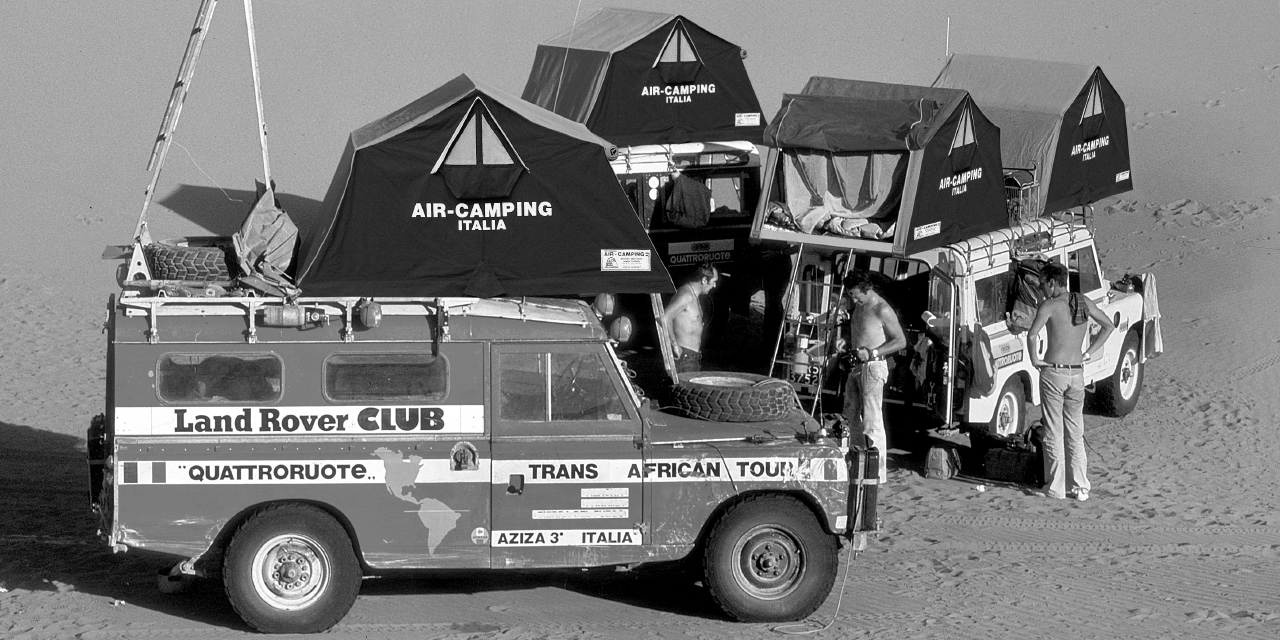
While Italian design genius brought us the Ferrari, domed architecture and, yes, the rooftop tent, it is Kickstarter that often brings truly new designs to modern consumers. iKamper emerged from the online crowd-sourcing investment phenomenon when, in 2017, it promised investors a re-envisioned RTT.
Based in South Korea, iKamper is the brainchild of Soon Park. A self-declared creative and self-trained engineer, Park began a design mission after a 58,000-mile journey that crisscrossed America along with his family. Fueled by that monumental venture and the faltering equipment they relied on, Park’s trip-inspired motto of “love people, love nature” birthed iKamper. The Skycamp’s design came from asking what a better RTT would need, and what it should achieve.
Frequently, new rooftop tent manufacturers differentiate themselves through color schemes, skylights and unique opening strategies. In that sense, the Skycamp isn’t exactly unique, as it incorporates several of those same types of changes. For instance, its brown/black combination stands out from competitors, as does its distinct logo. That’s nice, but it won’t help you in the backcountry. Similarly, its integration of a moonroof allows users to escape tent claustrophobia, which some users will value, but it’s not one of a kind. Where the iKamper Skycamp scores performance wins is in its living space and ease of operation.
Table of contents
Design Innovations
To understand what iKamper brought to this rapidly expanding product sector, it’s helpful to point out the two major groups of these tents. They are either flip open, soft-top configurations, or they use hard-shell protection and open either vertically (using lifting devices) or tilt up (via a single end hinge). In other words, the RTT market is composed of the same two fundamental designs that the Italians conceived and released between 1957 and 1959. Hard-shell configurations remain fast, secure and less spacious. Flip tops dominate the market, cost less, require more set-up steps, and still boast more room than hard-shells, owing to the doubling of their footprint when unfolded.
The iKamper Skycamp, however, promised the “best of both worlds.” It did this by blending a hard-shell, using gas strut assisted opening, and a flip open floor. Its larger-than-average footprint when closed meant the design can accommodate more mattress and larger sleepers. The result is a unique aero shell that uses only two (lockable) cable latches to release/secure it, and which requires only a one-handed lift of the shell (~9”) to engage the strut’s well-matched hydraulic action.
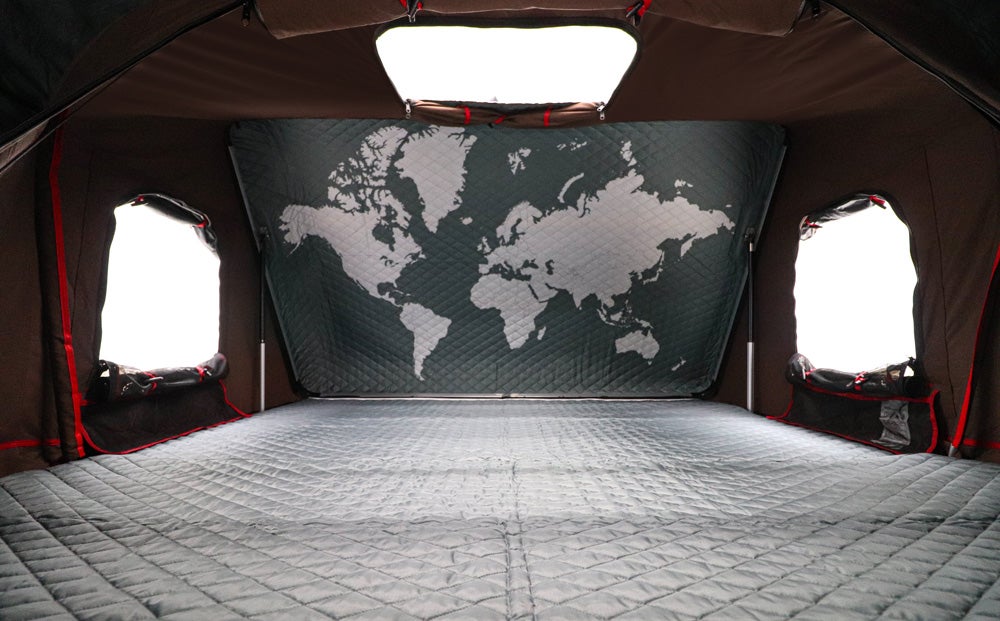
When it came to interior space, designers opted to go big. The iKamper Skycamp unfolds to provide a King mattress and roof that peaks at 3’ 6” high. The result is a living space that is spacious for two, and can even shelter a small family. That much-touted interior impresses immediately. Its volume conjures up the possibility of 4-6 people playing cards sitting inside, or how easily a couple with children (or dogs) could nod off. As rooftop tents go, it’s a wonderfully spacious cavity for sleeping or simply relaxing.
Besides speed of setup/stowing and usable interior space, Soon and his designers addressed other nagging needs in the rooftop tent market as well. First, a range of Skycamp accessories integrate into the tent, expanding its basic functionality. Our model came with a trio of those add-on’s, which included the tent’s two attachable shelters (Annex Room and Awning), the cold weather insulation liner, and a pair of storage organizers. The latter can hang from the handy adjustable metal loops attached to a track under the floor, enabling hanging access to shoes, clothes and whatever else is stored in the numerous pockets. These and other accessories extend ways in which the tent can support user needs, and help in customizing user options.
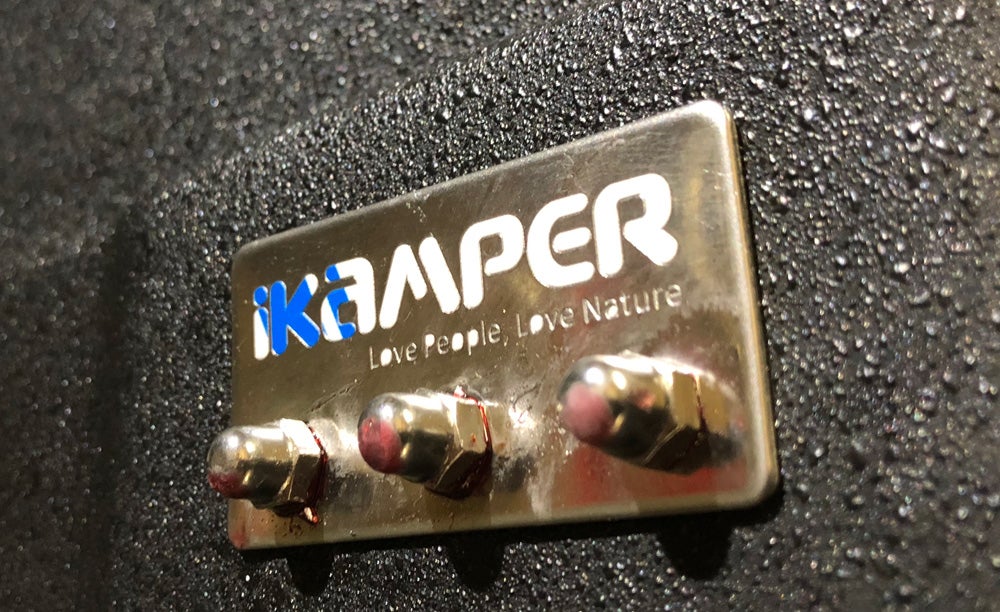
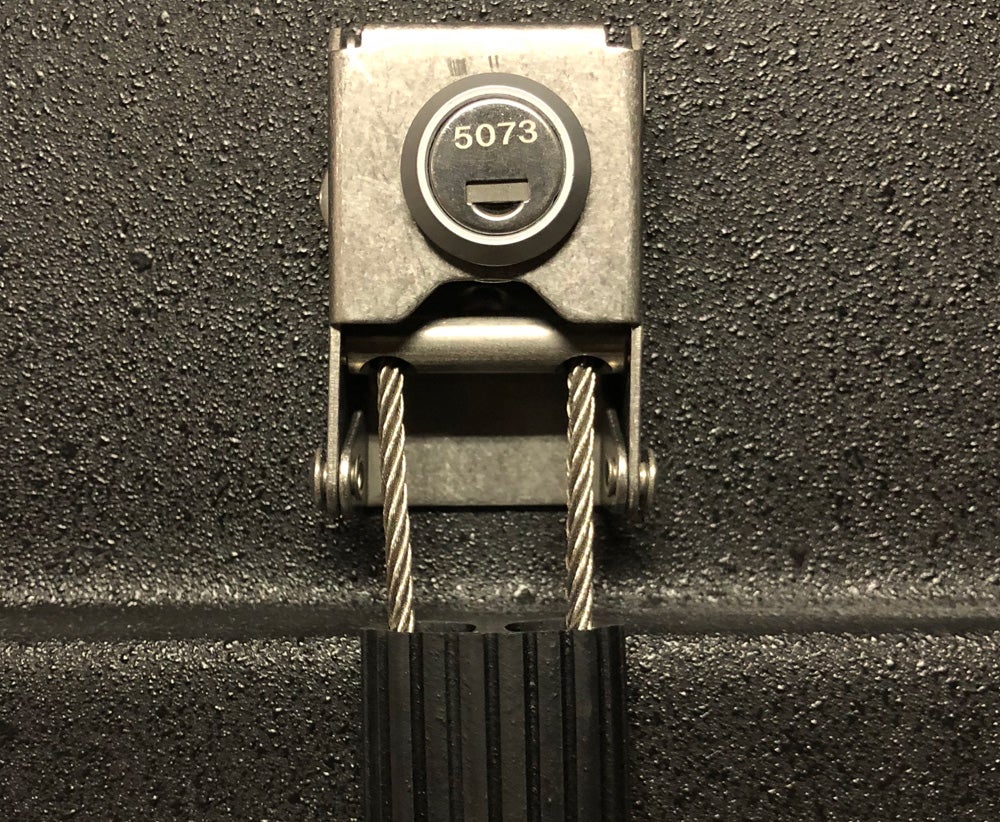
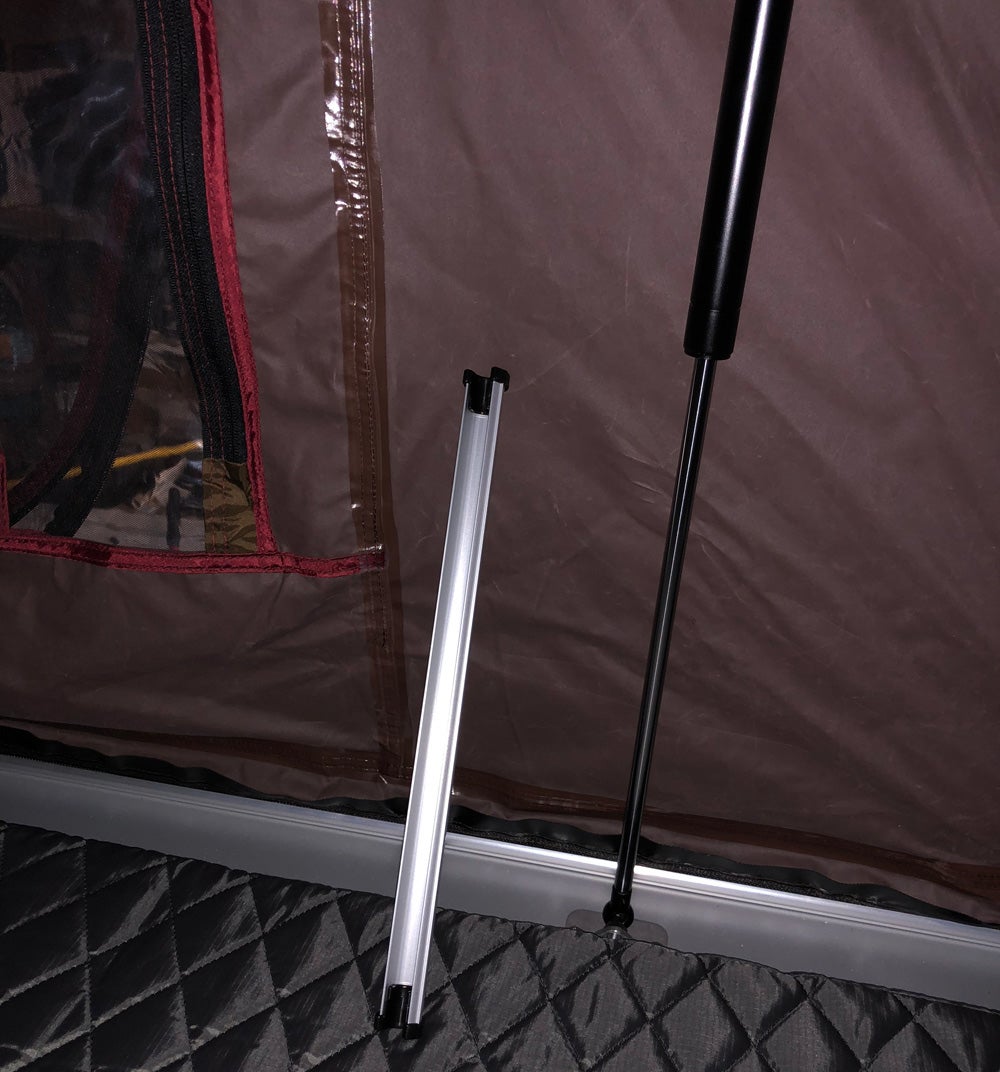
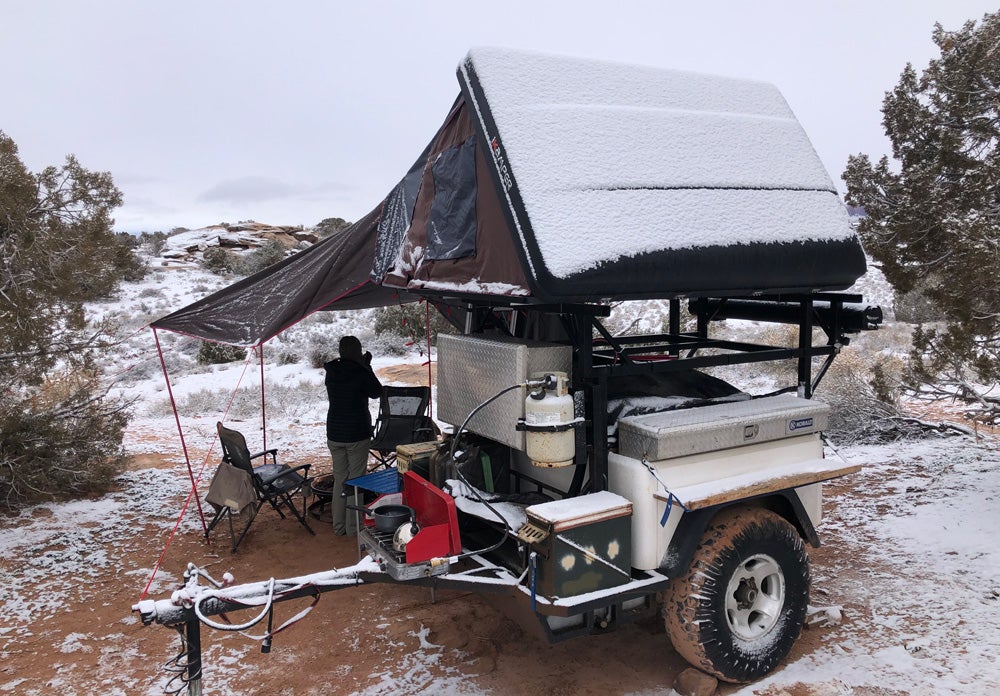
Less obvious are the design problems inherent in flip open RTT designs that the iKamper Skycamp addressed. Instead of being buffeted by winds, the hard-shell design allows deflection of gusts if oriented in a windward fashion. A ceiling “window” (aka “Skyview”) offers interior light and star viewing without sacrificing privacy. If these options weren’t enough, the tent’s body can actually be swapped out for a model emphasizing breathability through mesh panels (and alternate color schemes).
The Skycamp we reviewed is the 3rd generation since iKamper launched its Kickstarter campaign. Raising over $2M, the company fulfilled funders’ orders in 2017 with release of version 1. The brand has since sold 7,000+ units, with 55% in North America.
For such a new product, the iKamper Skycamp has already seen multiple improvements. The hardshell cover has been chief among them. The cover was reinforced to add rigidity in the 2.0 version. For those expecting to test that strength by running into tree branches and worse, the Rocky Black option takes a cue from truck bed protection, giving the cover a thin Line-X coating. This new option is intended for overlanders or anyone who travels in dense forests, and is how our test model came equipped.
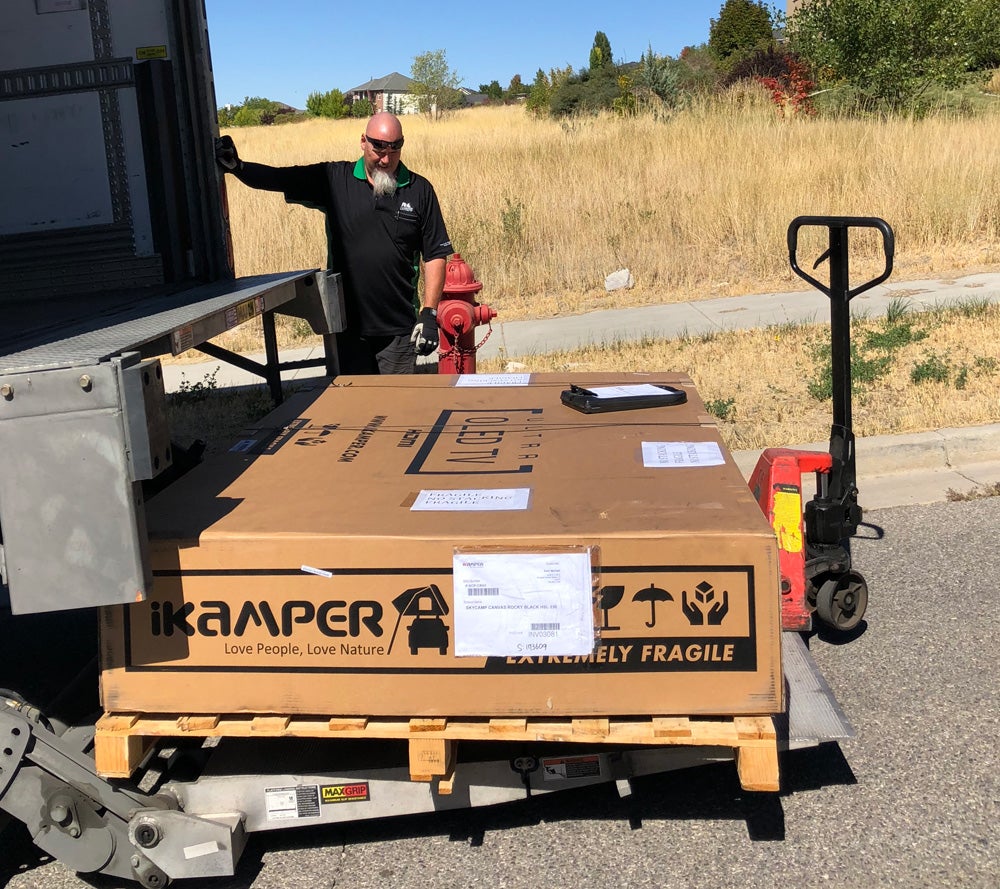
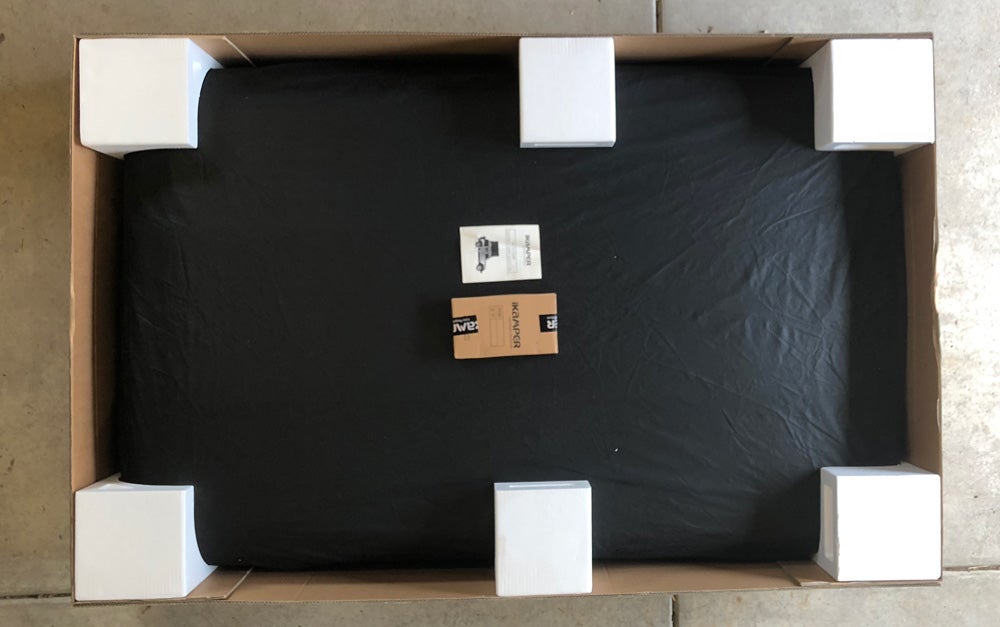
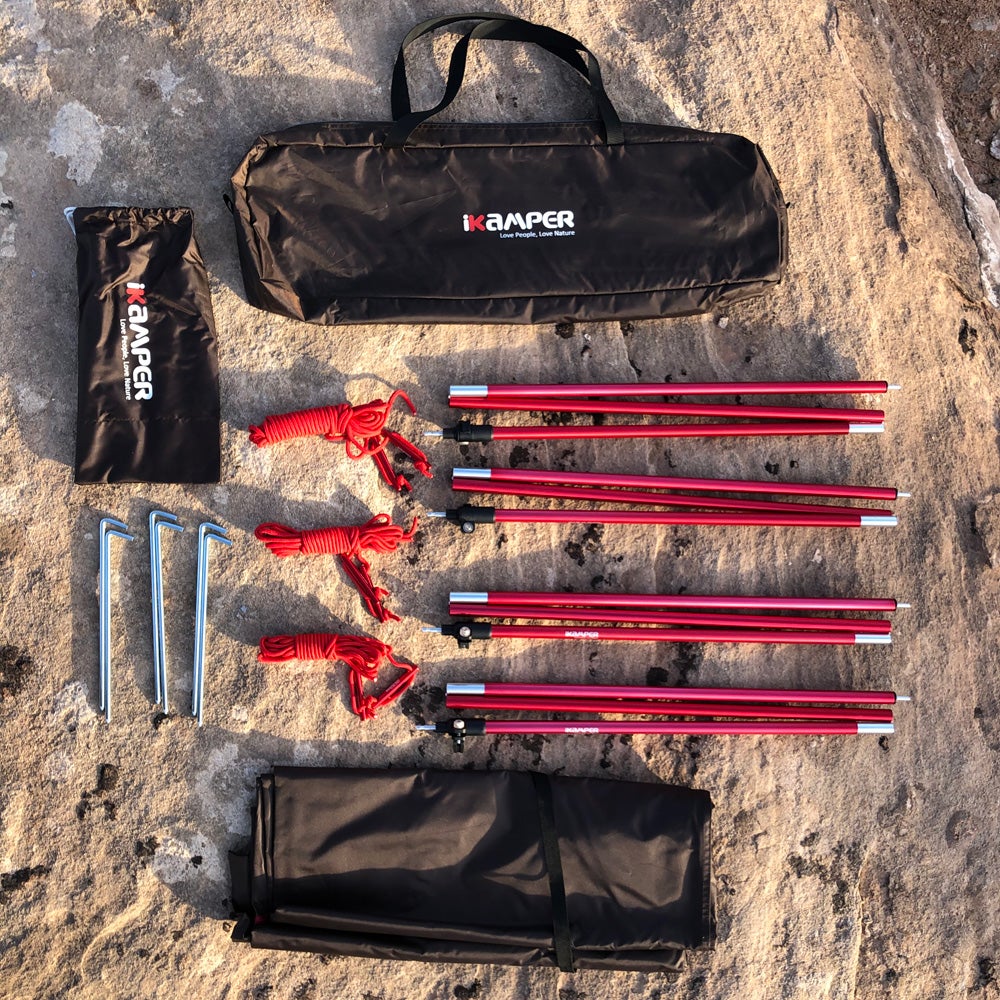
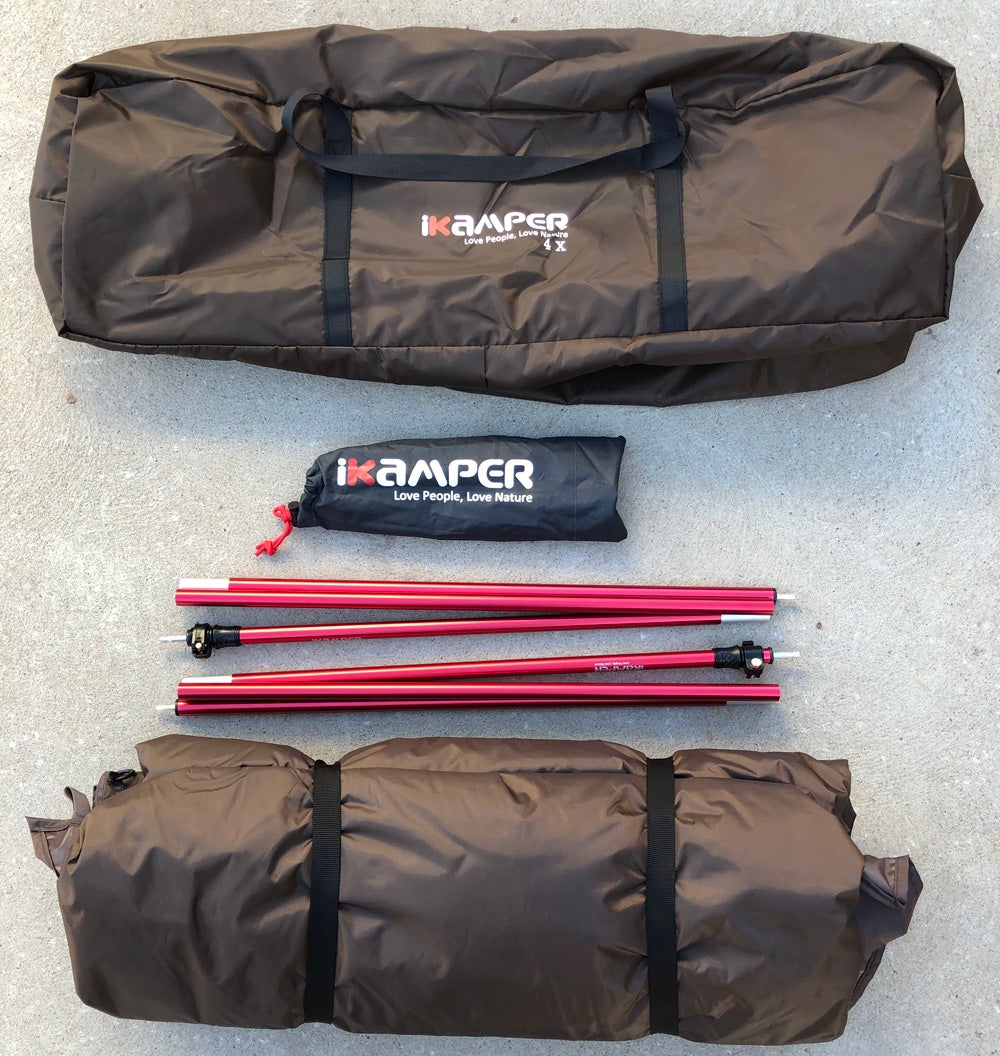
Construction
Once you peel away the exterior of a rooftop tent, the core is its platform and mattress. Platforms have evolved from simple, cold plywood boards (Ex: Eezi-Awn) to rigid laminates. More than just flat foundations on which to lay a mattress, platforms are what determine if you sense flex in the span beneath your bed. The iKamper Skycamp’s platform is built from a sandwich of honeycombed aluminum, resulting in a hollow, insulating airspace below you. The rigidity of the material virtually eliminates any perceptible flex. How rigid is it? iKamper illustrates the material’s strength in its dramatic demonstration of a Jeep driving atop a small bridge of the material.
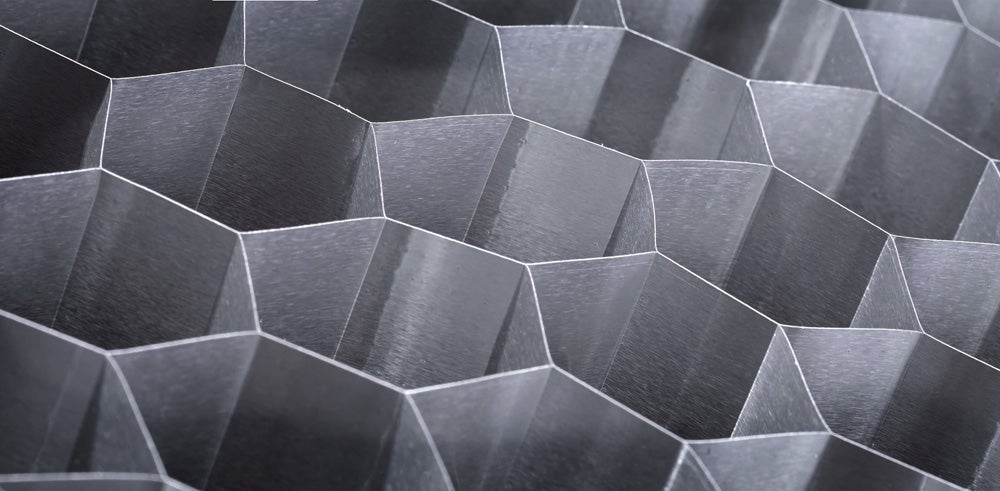
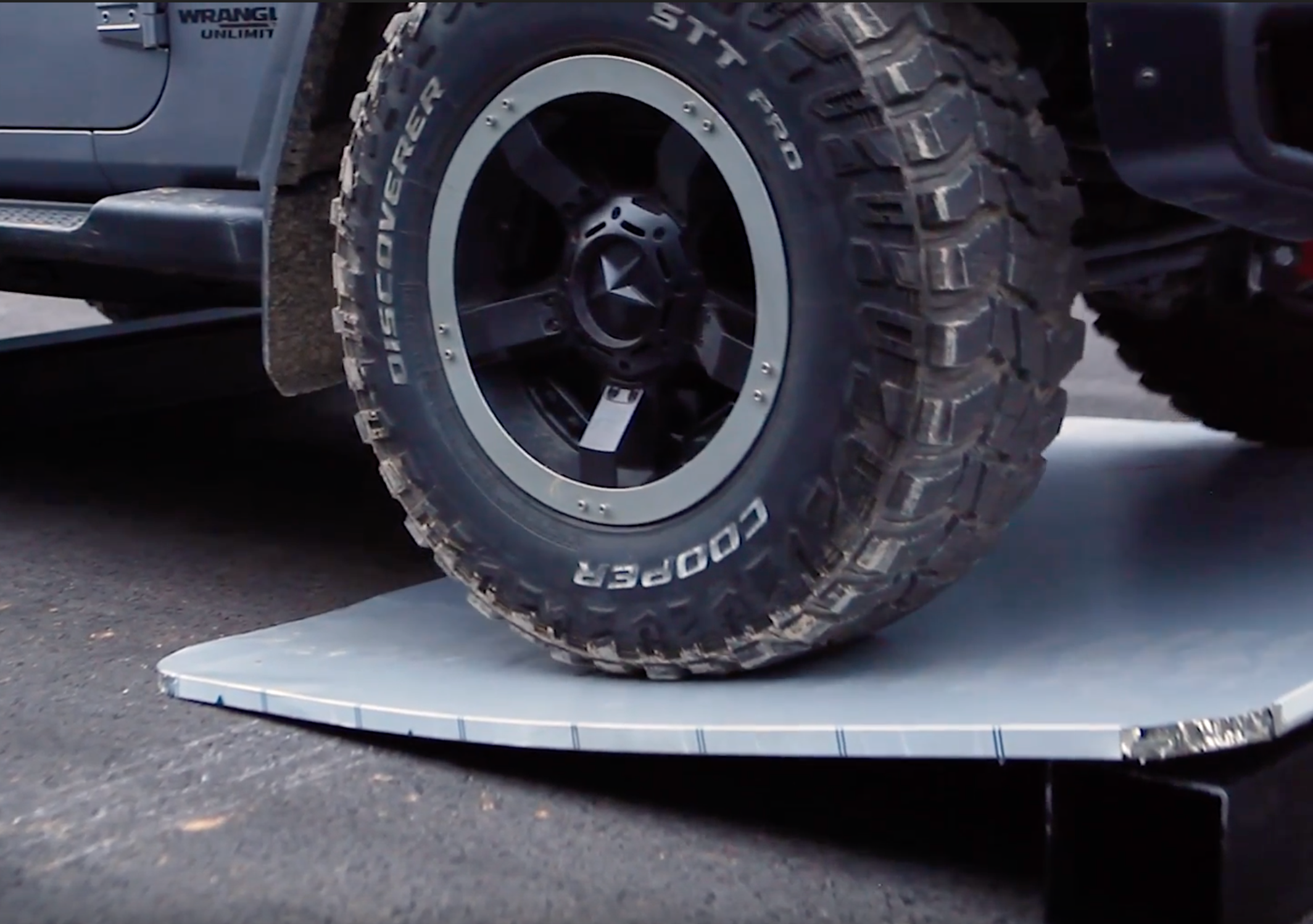
Rigid platforms provide the base, but mean little without adequate padding atop them. Starting with the v2.0, Skycamp models were equipped with the brand’s new, thicker mattress. Composed of a 5cm memory foam core, and encapsulated by a quilted zip-off poly cover, the mattress is 25% thicker than the original version. Made of two sections, the mattress can be doubled up if sleeping solo. When laid out as normal, the combination of the two sections yields a King size bed.
Mounting
At 160 lbs, the iKamper Skycamp, like most RTT’s, requires extra hands and confirmation of your roof rack’s capacity. Despite its size when open, iKamper has kept the weight in the range of competing manufacturers’ tents. Due to their bulk and weight, such tents requires that the rack they are attached to has adequate capacity. This may exclude some factory systems. Like most brands, the Skycamp uses two aluminum tracks under its platform for added rigidity and ease of aligning brackets to your rack’s crossbars. Stainless steel hardware that is provided accommodates a wide variety of bars.
To hoist the tent for mounting, we used a ceiling-mounted electric hoist. With this system, even large RTT’s can be removed or mounted by one person. In the case of the iKamper, its rails easily bisected the bars of the Dinoot trailer rack, with the four sliding brackets being positioned as the tent was slowly lowered. This approach has several advantages over gathering a small group of friends to lift a bulky RTT, not the least of which is making adjustments.


Living with the Skycamp
Convenience. Protection. Comfort. Above all, those three performance areas define market expectations for RTTs. iKamper boasts that the newest Skycamp delivers on those in spades. To test the claims, we lived with the 2.0 for a year, camping in it through all seasons, and all manner of weather.
Traditional flip RTTs appear convenient at first, but users soon learn they require several steps, involve dusty covers, and lack automatic opening, whether opening or closing. Hardshell tents require less steps, yet their volumes are reduced. iKamper created a hybrid that offers much of the convenience of a hardshell with more volume than all but the largest flip RTTs. The difference has been significant in living with the Skycamp.
Claiming a mere 1min setup, iKamper isn’t exaggerating when it comes to the stopwatch race for basic setup. Rather than working your way around the tent’s exterior to fully undo a cover, users can stay put on the opening side of the Skycamp. The 5-step process is, in fact, literally a 60-second effort. That’s hard to beat in today’s market, though folding up the tent still necessitates a manual pull and tucking in the folds of fabric.
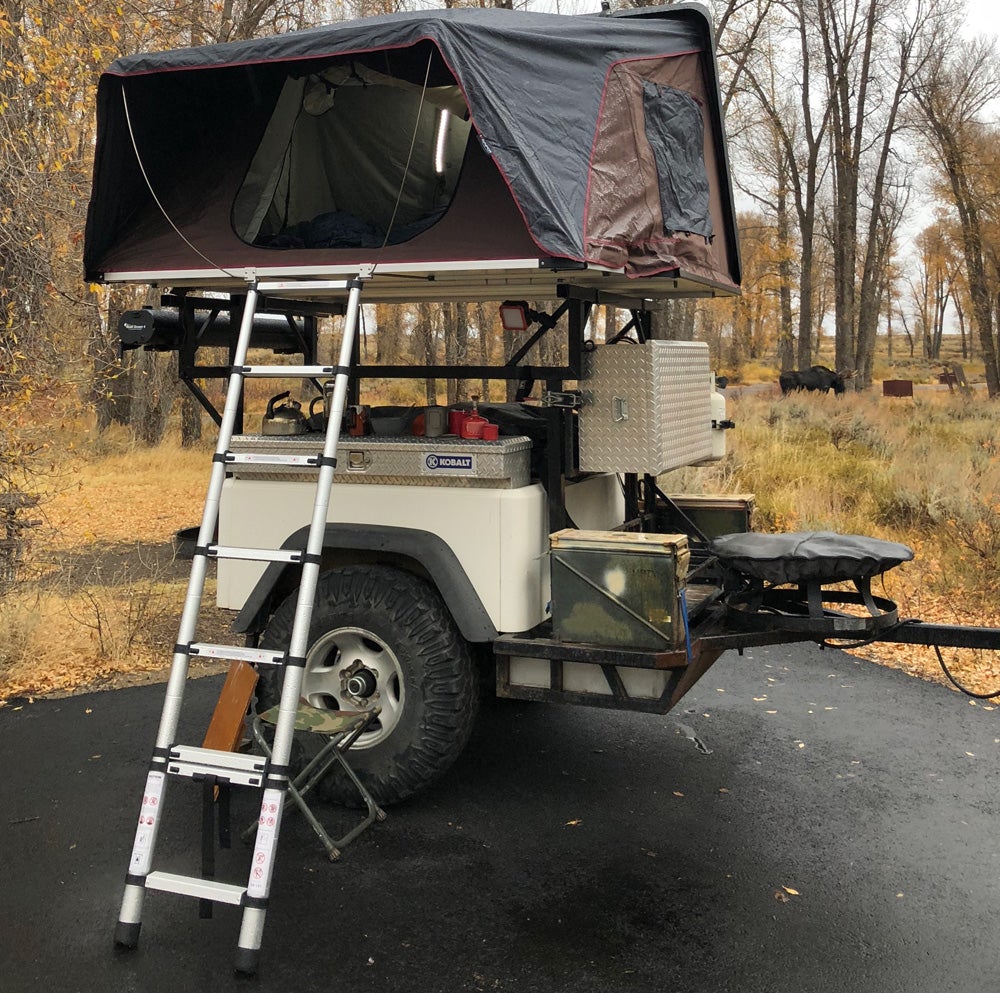
The tent’s rapid deploying ladder and entry/window awnings are quick and will seem familiar to previous RTT users. The adjustable-length ladder is comfortable on bare feet, offering flat rung surfaces – something other manufacturers should learn from – while handling heavy users (330lb max weight) with its posi-lock engagement as each rung drops and clicks in as gravity automatically opens each section until the ground is met. Strong and lightweight, the ladder’s only functional flaw is how added friction can result from grit or sand infiltrating the telescoping aluminum joints.
Once inside, the spacious iKamper Skycamp can feel a bit decadent for two, and embarrassingly empty for only one traveler (hence the new smaller and 40lb lighter Skycamp 2x and the just released 2-person Mini). The interior’s volume takes you by surprise, given its exterior appearance and smaller flip-out platform. Is all that space excessive for two? On the contrary, the Skycamp seems just right. It allows duffles, footwear and a laptop and its power supply to not crowd the occupants. Sitting up to read, type or play board games feels natural (especially if you stash a Crazy Creek chair in it for evening use). The entryway, along with both side windows, can be sealed from light and bugs or left open depending upon the desired conditions.
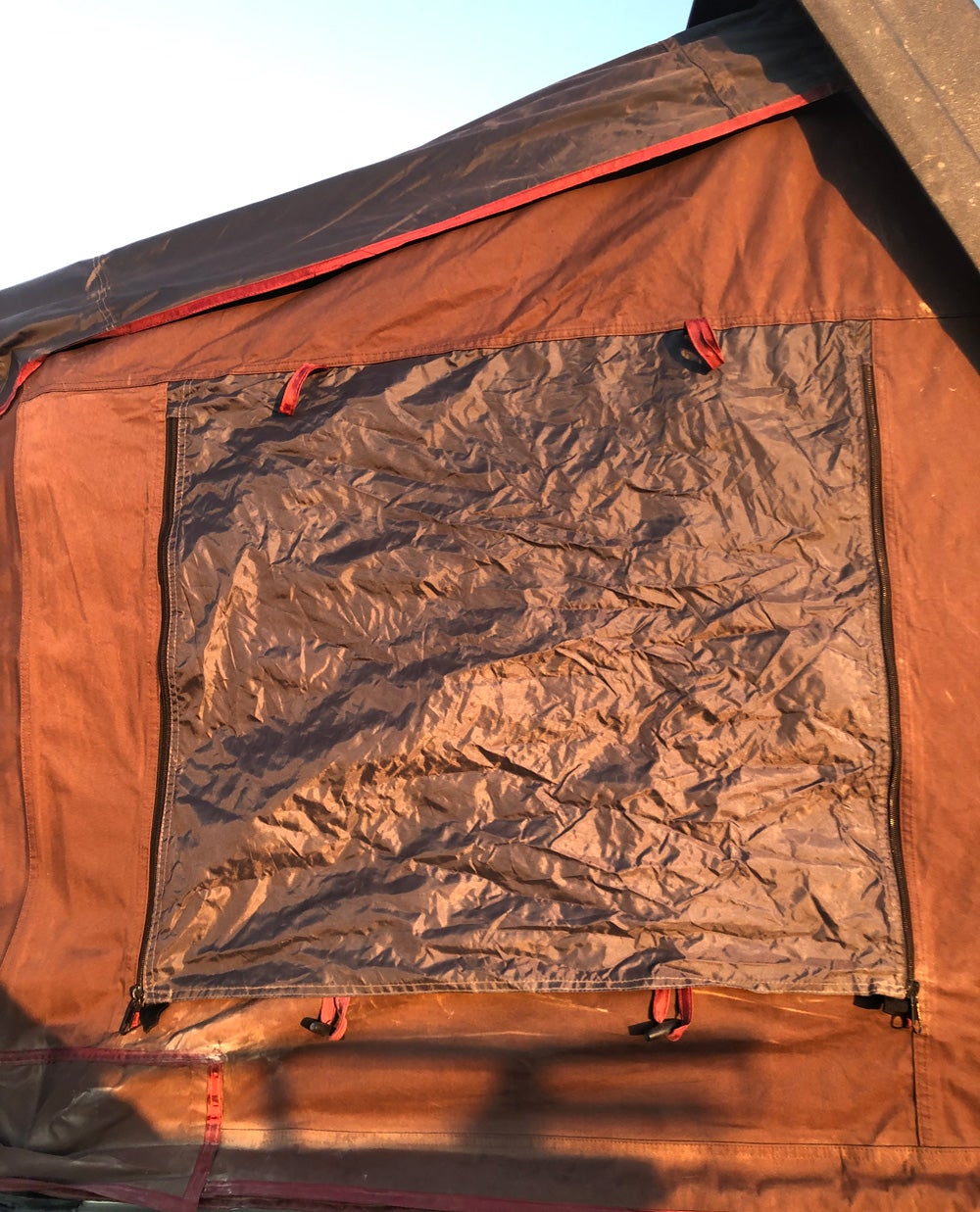
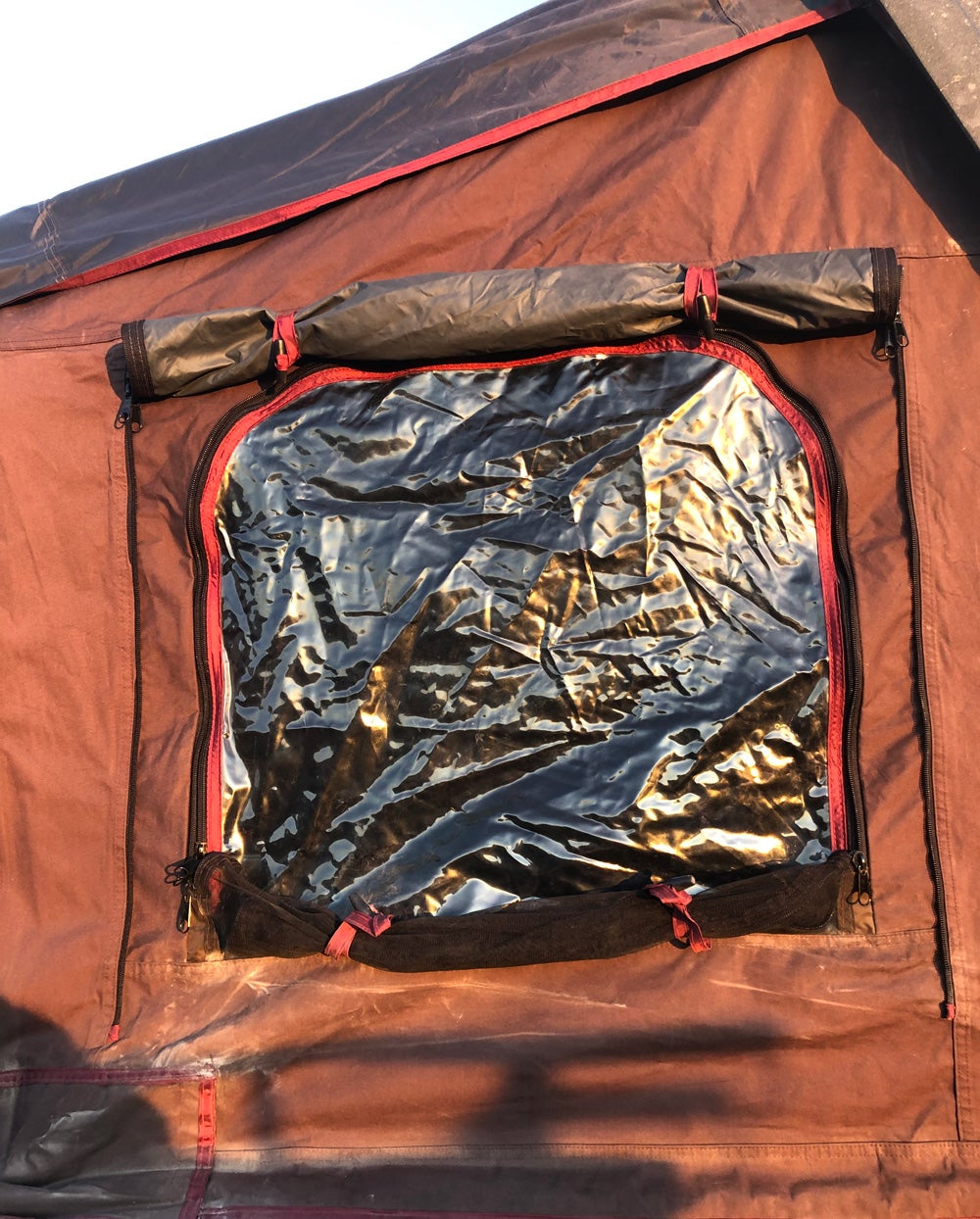
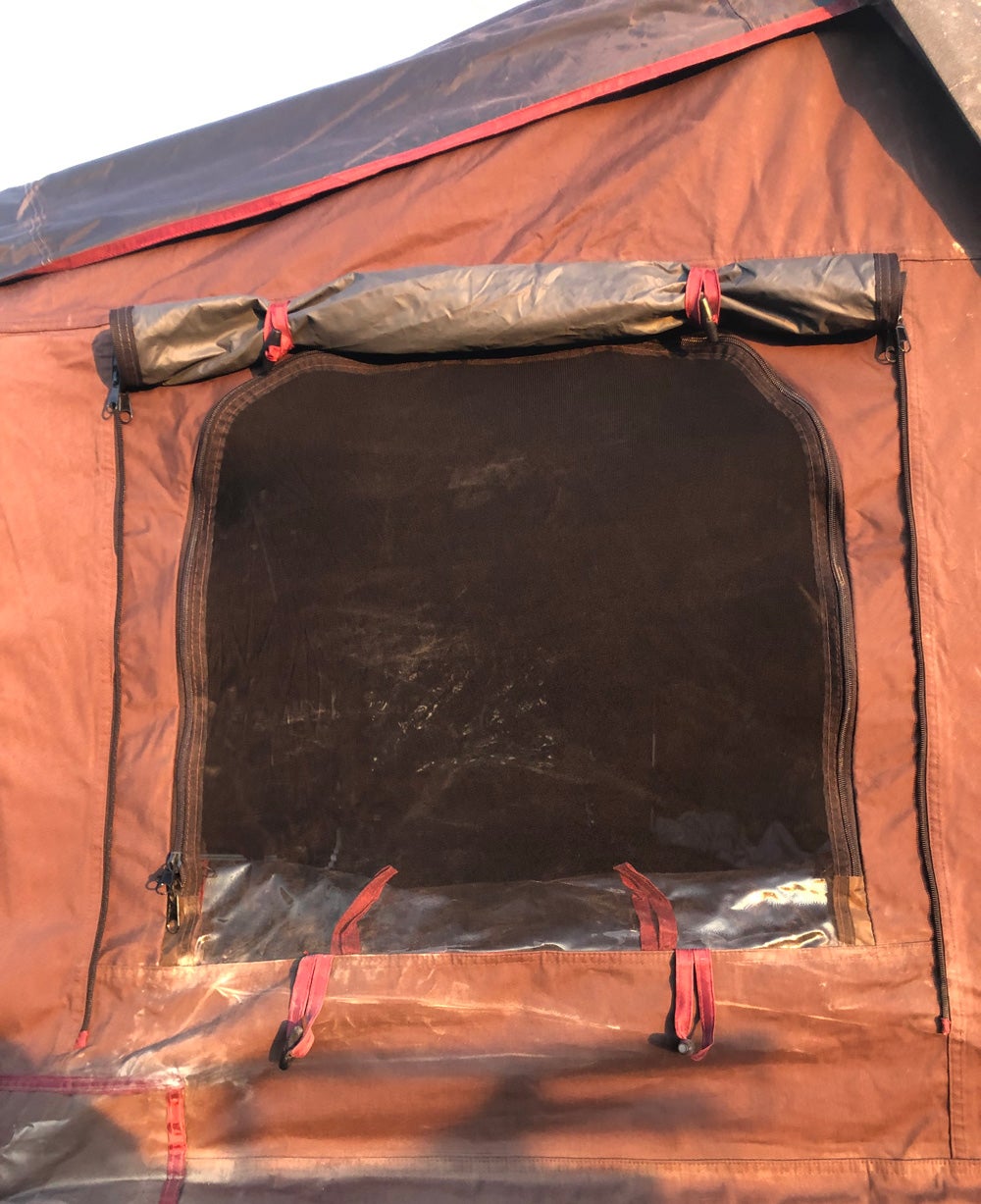
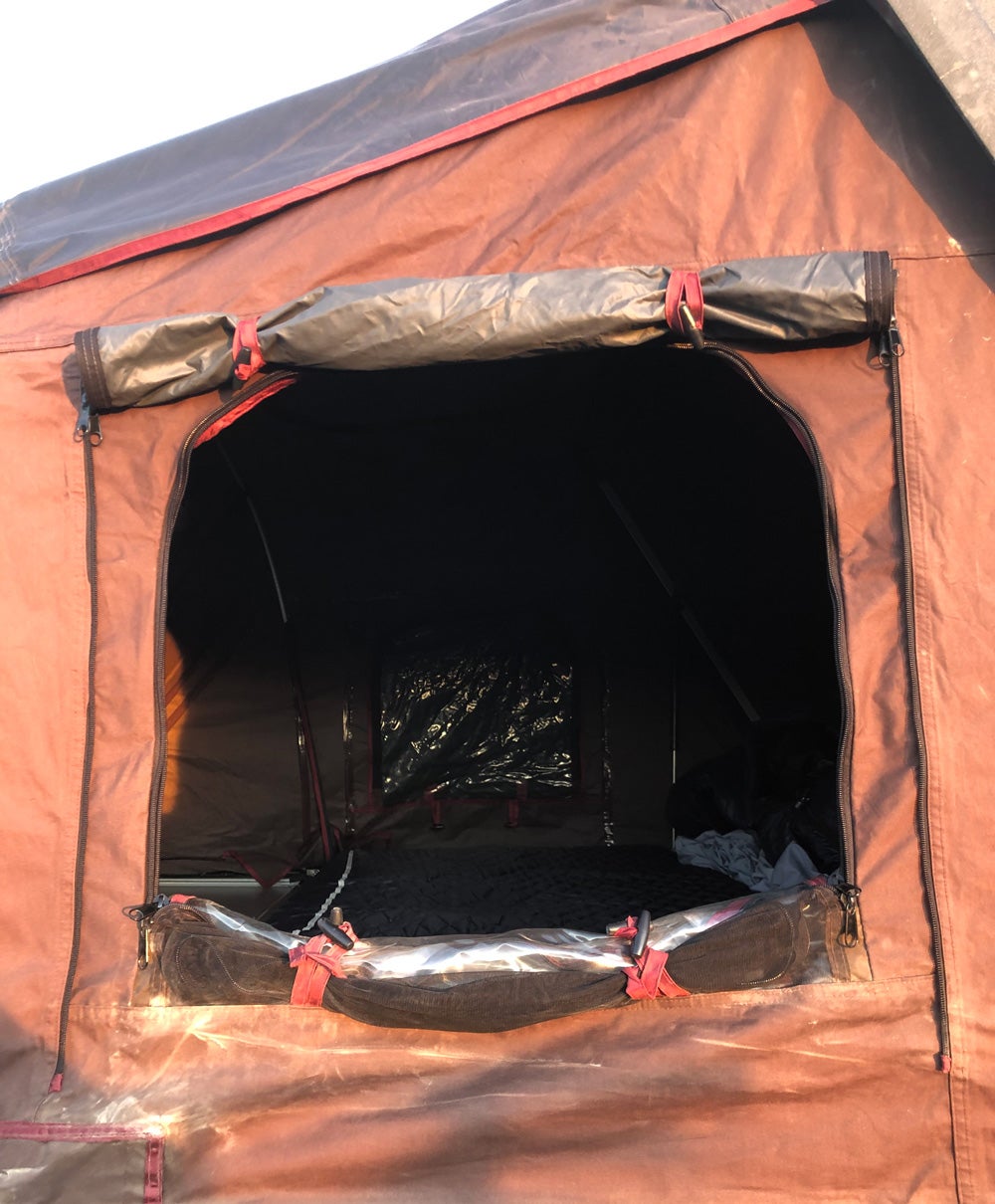
That same generous volume is needed when using, during icy winter months, the company’s handy insulating liner “tent”. Similar to the tipi liners, or “ozans”, used by Plains Indians, iKamper’s liner creates a full interior barrier. From our use in freezing autumn trips through the Tetons and Northern Rockies, the liner is a must-have. Using an infrared thermometer we found it reliably added 7F degrees, as well as isolating condensation away from sleepers and their gear.
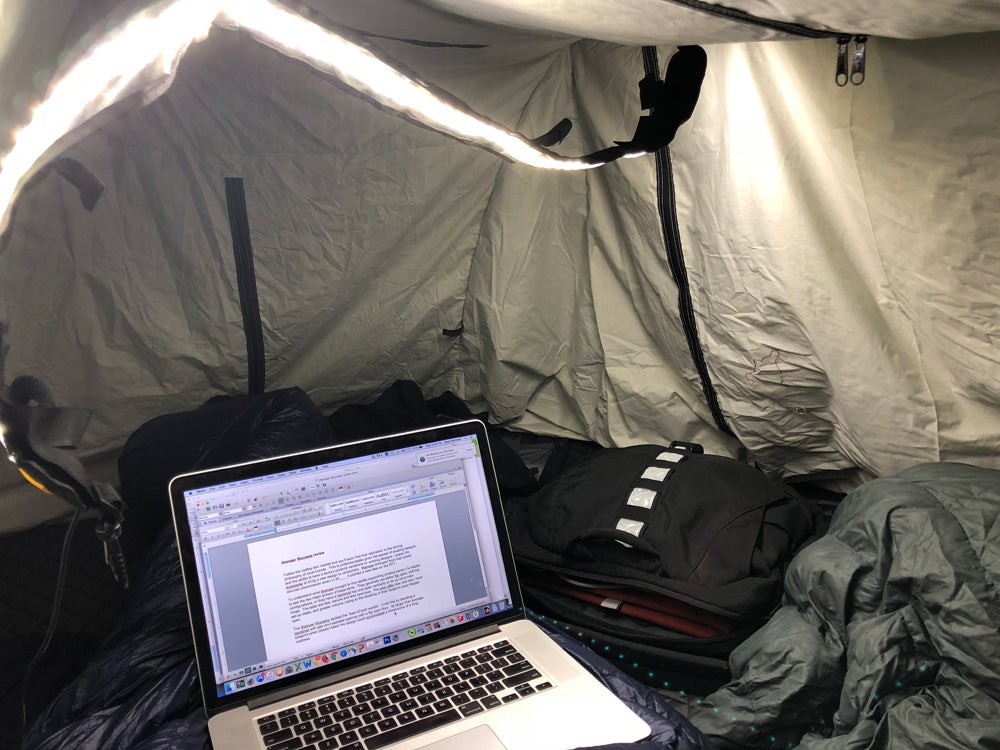
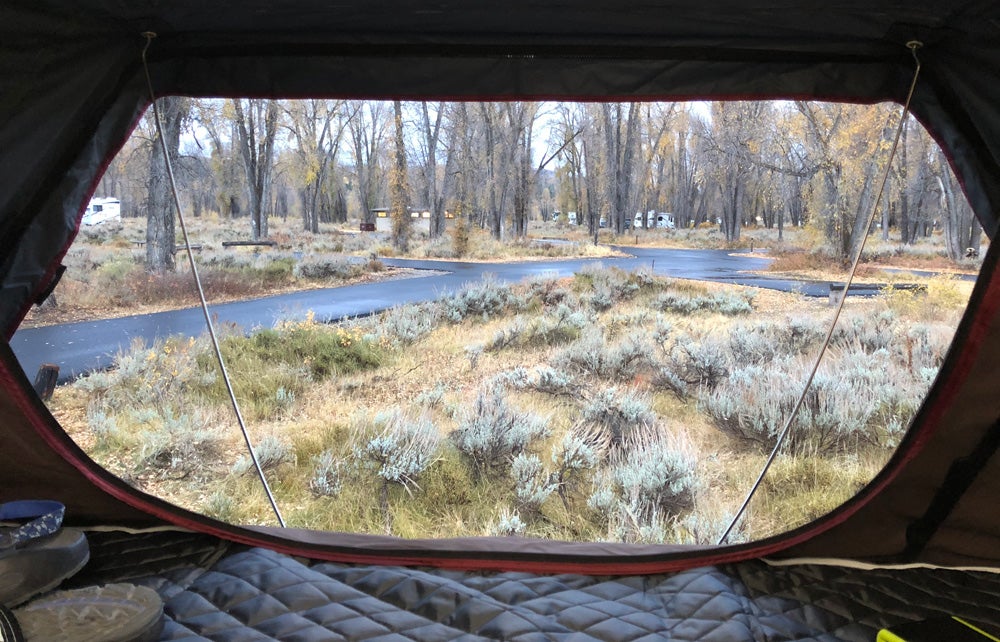
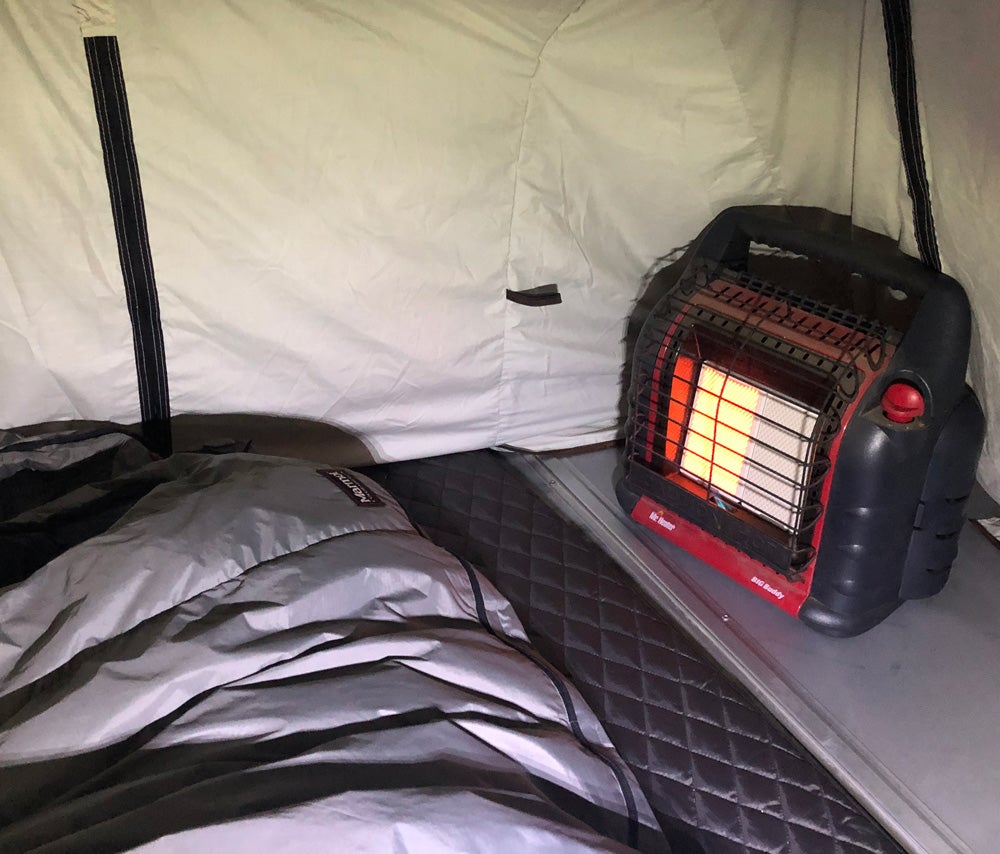
The only difficulty we’ve encountered has been closure when additional items – pillows, sleeping bags, etc. – are left inside the tent. Although much improved over other RTTs, the Skycamp can be a challenge to close when bedding and such is left where it should be; inside and ready for the next night. Using light down bags and thin pillows will help this problem, but don’t expect to store thicker or more dense items. To iKamper’s credit, they have probably made more progress in this sadly overlooked need than any of their competitors.
When the shell’s closure meets modest resistance from stored bedding, the solution is twofold: use down comforters, and stack bedding thoughtfully. This isn’t difficult, but takes some extra care. For instance, when pulling downward on the cover isn’t enough to engage the locks – and usually it is, especially there are two of you – applying one’s weight atop the cover helps press it down. Alternately, when more items are stowed (e.g., when winter camping with thicker sleeping bags), a little more oomph is needed. For that I’ve found a simple loop strap run over the cover – attached to a rack on the other side – provides an easy means to add down pressure, enabling an easy closure of the sturdy cable latches.
Add in the handy (and occasionally over the top) interior accessories and the iKamper Skycamp serves up a great escape from the outside. And that brings us to the main event: the mattress.
The mattress is the heart of a tent’s user experience, so if it doesn’t sleep well what’s the point? Because RTTs get you off of uneven ground, rocks and roots, it’s possible for them to use thinner mattresses. They simply don’t need to absorb as many bumps and knobs. The iKamper Skycamp version 2.0 has added foam to the original’s mattress, and measures a full 2” thick. That’s a reasonable thickness, though not excessive by today’s standards. As with any mattress, equally key is the foam’s material characteristics.
iKamper’s memory foam is a of medium to light density variety. If you kneel on it, for instance, the foam doesn’t prevent your kneecaps from pressing thru and feeling the platform below. Similarly, if you prop up on an elbow, the aluminum below is felt. Neither of those positions is the norm, though they routinely occur, such as when climbing in. So the real question is does the modest density of the memory foam provide enough support when sleeping?
At 6’ 3” and 185 lbs, my build has plenty of bony points – hips and shoulders and knees – to test cushioning. The low resistance of the Skycamp’s mattress to point pressure means it readily gives as you roll over. Compared to the density of other RTT’s we’ve owned, the mattress in the Skycamp easily deforms to a prone body. Others have either required a supplemental pad underneath (e.g., Eezi-Awn), or felt firm to the point of not compressing beneath non-bony contact points (e.g., Hinterlands).
All of these mattresses use single density foam, and in many ways that makes them more similar than different. And it’s also why they are not particularly sophisticated. The iKamper Skycamp mattress leans towards the ‘too soft’ end of the spectrum. Its responsive memory foam would benefit from a centimeter of added thickness, provided that it was a higher density material akin to a yoga or Ensolite mat.
For comparison, when camping solo in the Skycamp, I have tried doubling up the mattress. The resulting 4” of foam is pure luxury. Used singularly, however, the mattress reflects more of the Asian nocturnal tradition of modest padding. Want more padding but traveling as a couple? Adding an anti-condensation matt below the mattress, or a ½” foam pad will boost comfort.
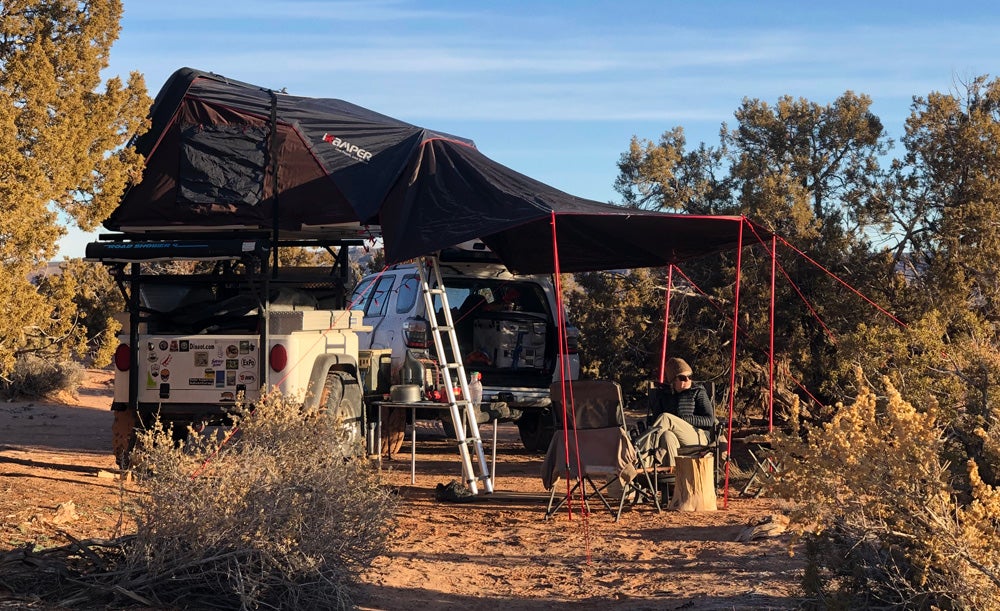
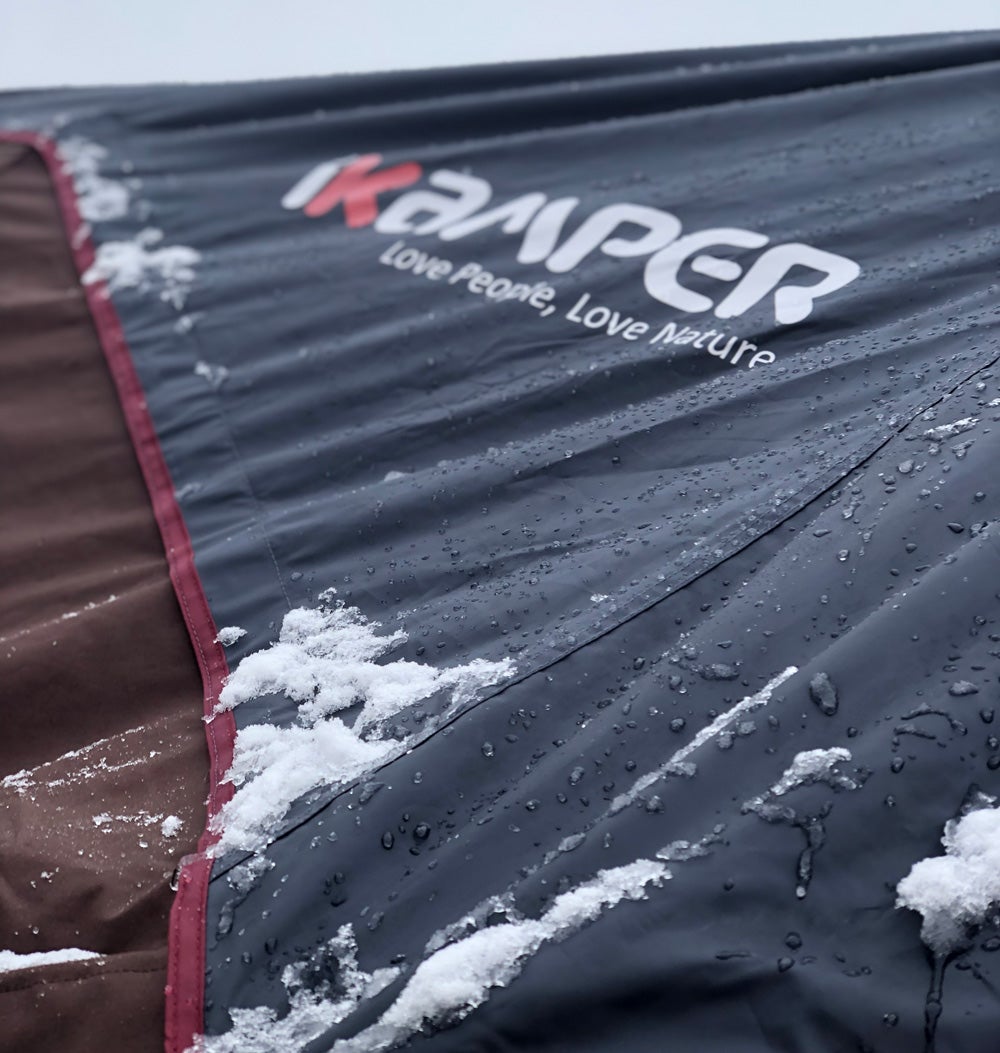
When you’re not sprawled inside the iKamper Skycamp, the numerous exterior accessories add versatility to camp living. The company’s three shelter add-on’s provide distinct benefits, with increasing levels of protection. The simplest, the Vinyl Canopy, merely shields the tent’s entry from weather; it’s basically a clear, zip-on fly. Designed for high wind conditions, it offers no protection for gathering outside the tent.
In contrast, the expansive Awning, which also attaches to the tent’s entry way via a beefy YKK zipper, provides a large shelter for escaping sun and precipitation. We’ve sat out rain, snow and blazing sun under its durable brown fabric. Relatively small to pack, the Awning adds a lot of versatility for the Skycamp. Conversely, if conditions don’t demand its use, the number of poles and guy lines required to secure it will dissuade routine set up by some owners, especially those traveling solo.
Shop for Mr. Heater Buddy Heaters
Anyone who has used an attachable room extension on an RTT has enjoyed the privacy and weather protection of these accessories. iKamper’s Annex Room is no different. Bigger than rooms from some competitors, the Annex Room uses the same strong, seamless zip attachment as the Awning and Vinyl Canopy. Thanks to its ample openings, the Annex can provide much of the open-air shade that the Awning offers. In cold/foul weather, this shelter is fantastic, and is easily heated by a Mr. Heater Buddy heater. In campgrounds or large gatherings, the Annex can double as a changing room, bathroom shelter, or even a show stall.
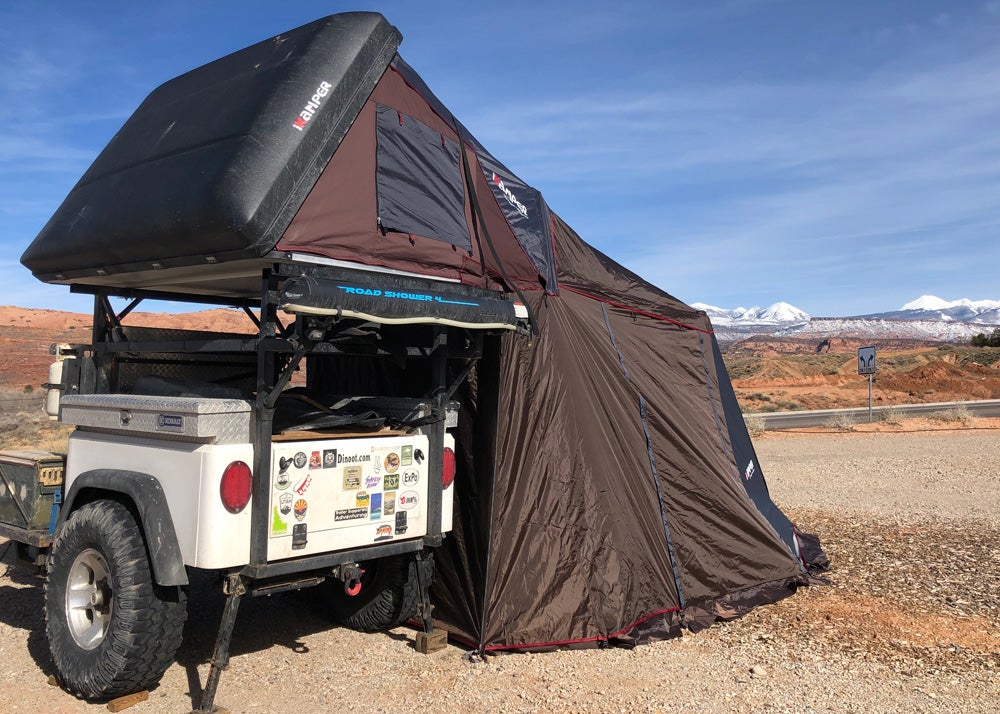
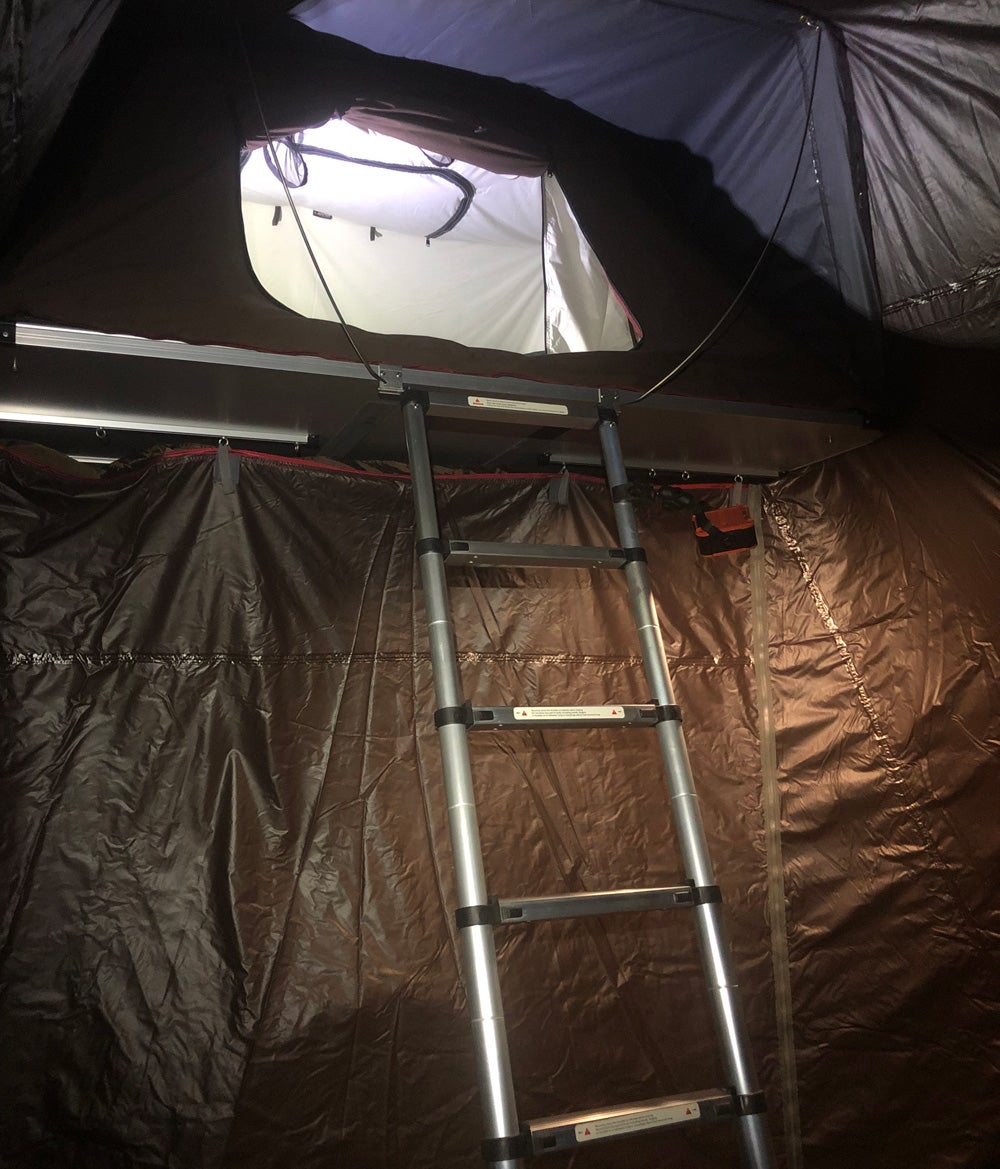
Outfitting the Skycamp
Completing the iKamper Skycamp’s plush interior needs two things: down and lighting. Using regular sleeping bags in the tent’s wide insides feels restrictive and downright silly. While functional, sleeping bags belong in a backpacking tent. In the Skycamp you want blankets to really sprawl out. The best we’ve used are from Nanga, a Japanese brand started in 1941, and named for a notorious peak in the Himalayan range where their products have outfitted high altitude mountaineers. Manufactured in Japan, Nanga sources the heart of its gear – the down – from Europe.
Nanga produces bags suitable for 8,000M peaks. The Kake-Futon (or “top blanket” uses 770-fill down and weighs 2 lbs, making these one-person covers feel weightless. Both versions – the standard and the Takibi – provide ample coverage (59” x 82”), and let us spread out inside the Skycamp. The latter model features a lightweight Kevlar fabric on one side, that’s both supple and resistant to campfire sparks. Its other side uses the same 15Dx15D water-resistant nylon as covers the standard model.
Nanga’s heritage of craftsmanship continues today, skipping the outdoor industry’s norm of outsourcing manufacturing to China, Taiwan and Vietnam. Its down undergoes inspection stateside by the IDFL (International Down & Feather Inspection Organization) for quality and verifying its spec’d fill power. Before use in their products, all down is washed and sterilized, using higher temperature and ozone treatments, as well as an antibacterial/deodorant application, in Japan. A hydrophobic treatment of Nanga’s down makes it competitive with current performance standards for such products.
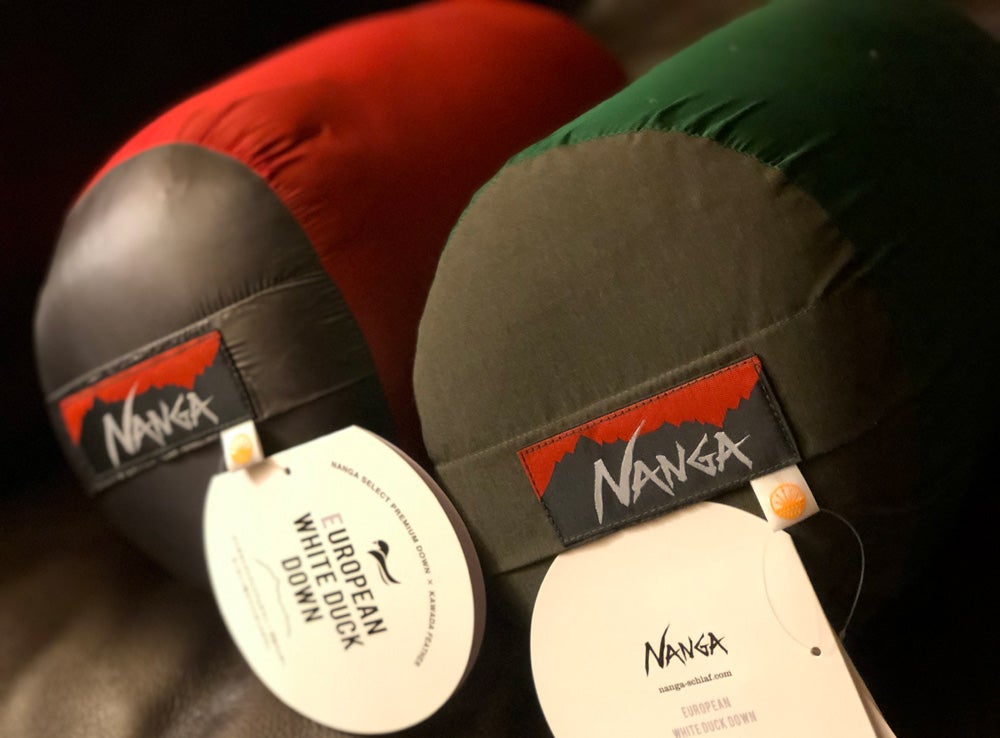

Each Nanga blanket comes in an ultra-slick stuff sack that makes stuffing a breeze, and featuring a two-stage cinch for improved protection. With the iKamper though those bags see little usage, since two of the uber-light blankets can easily be left inside when the RTT is close for travel or storage (a challenge with poly-fill blankets). Along with a set a sheets, this setup makes the Skycamp ready to roll and (almost) embarrassingly luxurious when you crawl in after a long dusty/snowy/muddy day on the trail. Adequate in warmth to ~30F, each version of the Kake-Futon makes the Skycamp’s inside a welcome relief when it’s time to crash.
Final Verdict
After more than a year of four-season use, we’ve seen how the Skycamp performs in rain, sleet, snow, wind and blazing desert temps. We love the overall speed and simplicity with which it sets up. With basic sleep gear already stashed inside, from killing the motor until you’re lights-out can take less time than brushing your teeth. Does all this speed and comfort really matter? The iKamper is liberating when it comes to making camp set up fast and easy. Until you experience a one-minute tent set up that freedom may be hard to fully appreciate.
And when camp is set up, I personally prefer to spend as little time in a tent as possible. But the reality is weather happens. And when it does (or when you pull in well after dark), you want a comfortable, weatherproof shelter. Even more so, when your RTT is the escape pod from snow, long nights, dust-filled wind or crowds, you don’t want it to feel constraining. Add a Crazy Creek chair, an LED strip and 12v power, and the Skycamp offers enough room to hide inside for hours in comfort.
iKamper has also built an RTT that slips through the wind on interstates and through branches atop your rig. Its construction is taut, sheds wind and moisture, and blocks out morning light to help you oversleep. Though not the most well-appointed mattress, its interior is spacious and, with the world map, the most attractive on the market. Despite its smaller overhead protection when standing under the flip open floor, the optional Awning and Annex give owners the option to easily expand on-the-ground shelter to their liking.
Innovative, highly functional, durable and supported by useful accessories, iKamper has effectively disrupted the RTT market with its designs. If you’re shopping for such a tent then the Skycamp, the Skycamp 2X, and the new Skycamp Mini (March 2020 release) are worth checking out.
About the Gear Doctor: Dr. Sean Michael has been designing, abusing and testing outdoor gear since the 1980’s, and began reviewing for Off-road.com in 2000. Today, he is Professor of Outdoor Product Design & Development at Utah State University, a product consultant, and a frequent Instructor at Overland Expo. Follow his trips and gear @thegeardoctor on Instagram.
We are committed to finding, researching, and recommending the best products. We earn commissions from purchases you make using the retail links in our product reviews. Learn more about how this works.
